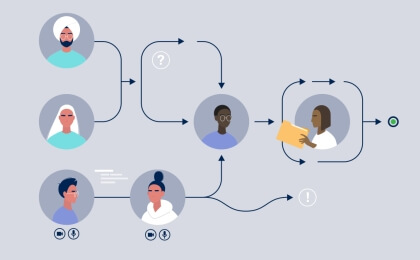Employers spend a lot of time and energy trying to reduce employee turnover. In an attempt to reduce turnover rate, many companies focus on making their work environment enticing enough to keep employees from wanting to seek greener pastures. This often means making large investments in their workers and their company culture in the effort to retain top talent.
And that’s certainly a worthwhile endeavor. But what happens when you’re the one asking your employees to leave?
When an employee is terminated, rather than leaving of their own volition, it’s called involuntary turnover. According to SHRM, more than one third of turnover a company experiences is from involuntary turnover (on average, an American company experiences an 18% annual turnover rate, 6% of which is the result of involuntary termination). This process can not only be emotionally taxing, but also financially costly: it takes a lot of time and money to screen, interview, hire, and train a new employee to take that person’s place. In fact, the U.S. Department of Labor estimates the cost of a bad hire at 30% of an employee’s first year salary. Although bad hires may seem like an inevitability, there indeed are measures you can take to reduce your rate of involuntary turnover.
Here are 3 adjustments you can make to reduce your involuntary turnover:
1. Attract and identify candidates who are most likely to succeed.
One of the best ways to avoid involuntary turnover is to hire the right people in the first place. Which feels painfully obvious, but also difficult to achieve. How can you know upfront whether or not someone will actually thrive in a specific position or connect with your company culture?
Well, it starts with cultivating the right applicant pool. Most candidates’ first impression of your company is through your job posting, and for this reason they are invaluable for attracting the kind of talent you’re after from the start. Be sure your job descriptions accurately describe job requirements, expectations, and your company culture. A carefully written job post can help attract not only more total applicants, but also more qualified applicants. And make sure all the requirements you choose to include are job relevant. In a tight talent market, you’re better off finding ways to opt candidates into your hiring pipeline than excluding them from the jump. This way you’ll have a larger and more diverse group of candidates to pull from when hiring.
That being said, more options don’t always make hiring easier, especially when you reviewing all of your candidates. Instead of trying to qualify candidates based on self-reported skills and experience, focus on more objective hiring data. Pre-employment assessments give you incredible insight into the skills, competencies, and potential your candidates possess and allow you to measure all your candidates’ abilities with the same yardstick.
Assessments help you highlight top applicants in your talent pool, regardless of how many applications you do or don’t receive. They also identify people whose cognitive abilities, skills, and personality are well-suited to the role, which makes them more likely to be comfortable on the job – and therefore, more likely to succeed.
By administering testing early, you get standardized, objective data on your applicants, enabling you to prioritize who you want to reach out to first. It also acts as an additional source of predictive information that can help you make more informed talent decisions.
2. The more you know upfront, the better.
Another way to be sure you’re hiring employees who are a great fit is by combining all the tools at your disposal to learn about a candidate before you hire. For instance, only reviewing resumes and conducting unstructured interviews can create unreliable representations of a candidate’s true ability. This can potentially cloud hiring managers’ judgement, leading to bias in the hiring process because so much of the hiring criteria is subjective if you only use traditional methods of candidate review.
However, when you combine information from resumes, structured interviews, and pre-employment assessment, you gain a much better understanding of your applicants as a whole and are more likely to make a smart hiring decision. Ultimately, a deeper understanding of the person that you’re hiring results in reduced involuntary turnover. When you know someone is capable and well-suited or the role, you’re less likely to need to let them go down the line. As a matter of fact, companies that have incorporated all these elements into the hiring process have seen improvements in training completion rates and overall employee retention. For example, one Criteria client found a 59% reduction in turnover after including basic skills testing and personality assessments in their hiring process.
3. Fine-tune your onboarding process.
But it’s not all about the pre-hire process. There are also steps you can take to make sure your new employees start off on the right foot once they’ve accepted the job. An important part of an employee’s future success in a company is making them feel like part of the team from the start.
During their first week, schedule plenty of activities to break up the monotony of new job paperwork. Group lunches, morning coffee runs, and fun activities can help everyone on your staff feel connected and engaged in the workplace. Even if you’re working remotely, scheduling some virtual games, happy hours, and get-to-know-you sessions can help your new hire feel like a valued part of the team. You may also want to assign new employees a mentor or buddy to help them feel welcomed and supported as part of your standardized onboarding procedure.
Making these efforts activates social glue between coworkers, which can help build healthy and effective working relationships, positive associations with work, and improved collaboration. When someone feels connected with their work and forms meaningful relationships, they feel more committed to the goals of your company and more productive on the job.
Training is also a big part of employee retention. If a new worker isn’t properly trained, they are much more likely to have lower productivity and perform poorly. Develop a consistent training program that you can use for your new hires to make sure you are using both your and your employees’ time as efficiently and productively as possible. Setting your new employees up for success from the beginning means that they’re more likely to succeed and become an engaged, productive team member.
Involuntary turnover can be costly to a business, but there are ways to reduce the likelihood of employee termination. By using all the tools available to gather predictive information before you hire, and by giving your new hires the support they need to succeed, you can minimize your risk of involuntary turnover and improve your bottom line.




